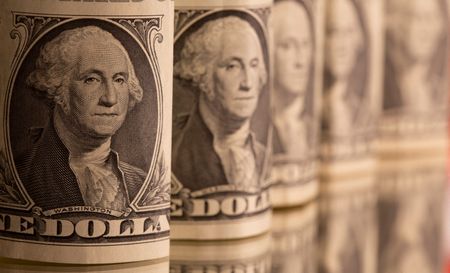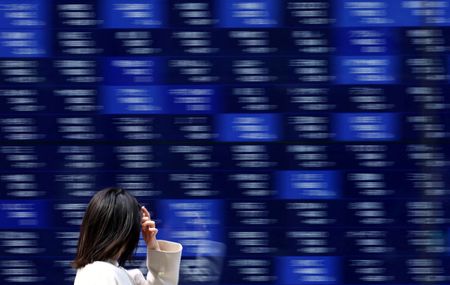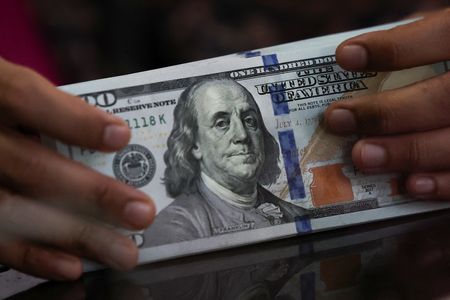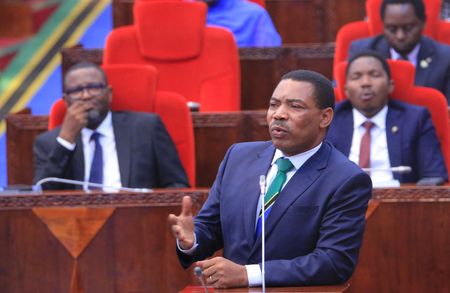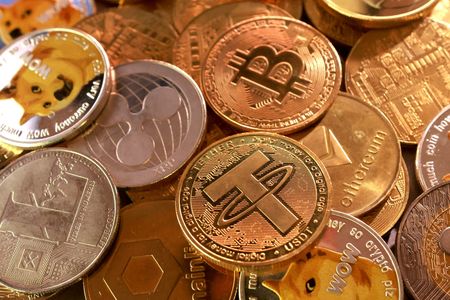By Gertrude Chavez-Dreyfuss
NEW YORK (Reuters) – The U.S. dollar strengthened against major currencies on Tuesday, led by gains versus the euro, driven by safe-haven bids amid tariff worries and tension-filled negotiations on the Russia-Ukraine conflict.
The Australian dollar, meanwhile, initially held near two-month highs after the Reserve Bank of Australia cut rates, its first easing since the 2020 pandemic, cautioning, however, against further rate reductions. But broad U.S. dollar buying amid global geopolitical stress has temporarily eroded support for the Australian currency.
Traders kept an eye on talks in Saudi Arabia between U.S. and Russian officials on Tuesday aimed at ending the Ukraine war.
Ukraine President Volodymyr Zelenskiy said no peace deal could be made behind his back. He postponed his visit to Saudi Arabia planned for Wednesday until March 10 to avoid giving “legitimacy” to the U.S.-Russia talks.
“The buck will remain a source of safety in the midst of uncertainty and what seems like a chaotic attempt at putting a very tragic and expensive conflict to rest,” said Juan Perez, director of trading, at Monex USA in Washington.
“Markets seem to be concerned with how cold relations are between the U.S. and EU (European Union) that the Saudi Arabia meeting between American and Russian leaders left EU officials out. It puts doubt on any original enthusiasm that emanated from the likelihood that Ukraine and Russia would find a middle ground and thus bring with it a better situation economically for all involved.”
In afternoon trading, the euro fell 0.4% to $1.0447, retreating for a second straight session. Last week, the euro rose to a two-week high on hopes of a peace agreement.
Russia on Tuesday, however hardened its demands for a peace deal, insisting NATO reneges on a promise it made at a summit in Bucharest in 2008 that Ukraine would join at a future, unspecified date.
U.S. President Donald Trump, meanwhile, has threatened new tariffs on the EU due to trade surpluses it had with the United States, in a widening onslaught economists say could trigger a global economic slowdown.
Against the yen, the dollar rose 0.3% to 151.95 . It earlier pared gains after data showed U.S. homebuilder sentiment tumbled to a five-month low in February on worries that tariffs would combine with higher mortgage rates to further drive up housing costs.
The National Association of Home Builders/Wells Fargo Housing Market Index plunged five points to 42 this month, the lowest since September.
The yen has been on the back foot after its recent gains, fuelled by strong growth data that bolstered odds of the Bank of Japan raising interest rates again this year, with July seen as a live meeting, instead of in the October to December period.
Japan’s solid October-December GDP data on Monday, coupled with recent inflation numbers, have helped lift the yen. It was up 3.5% against the dollar so far in 2025.
Sterling eased 0.2% to $1.2598, hurt by a strong dollar despite data showing accelerating British wage growth. [GBP/]
Investors will also focus on Wednesday’s release of minutes of the Federal Reserve’s meeting in January that may show how policymakers accounted for the risk of a broader tariff war resulting from President Donald Trump’s trade policies.
Data last week showed U.S. consumer prices increased at the fastest pace in nearly 18 months in January, reinforcing the Fed’s message it was in no rush to resume cutting rates amid growing economic worries.
U.S. rate futures have priced in about 37 basis points (bps) of easing in 2025, compared with 41 bps late Friday, according to LSEG estimates, using the January 2026 futures contract. Futures also implied the Fed will likely resume cutting rates either at the September or October policy meeting.
The dollar index, which measures its performance against six other major currencies, was 0.3% higher at 107.08, not that far from the two-month low of 106.56 touched on Friday.
In Australia, the RBA cut its cash rate by 25 bps to 4.10% on Tuesday and said it was cautious about prospects of further policy easing.
The Australian dollar slipped 0.1% to US$0.6349 after an initial burst of choppiness following the decision. The Aussie touched a two-month high of US$0.6374 on Monday and was up 2.4% in February. [AUD/]
Swaps imply just a 20% probability for a follow-up cut in April, although a move in May has been priced in.
(Reporting by Gertrude Chavez-Dreyfuss; Additional reporting by Greta Rosen Fondahn in Gdansk and Ankur Banerjee in Singapore; Editing by Christopher Cushing, Tomasz Janowski and Chizu Nomiyama and Marguerita Choy)

